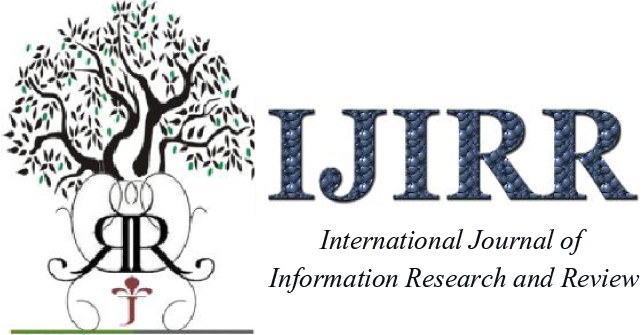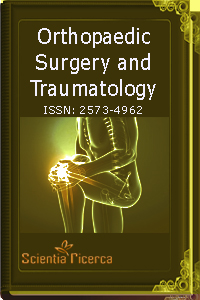Research Article
Volume 1 Issue 6 - 2017
Epidemiology of Bone Tumors in Dakahlia, Egypt. Does it differ??
1Assistant Lecturer, Mansoura University, Egypt
2Assisstant Professor, Mansoura University, Egypt
3Professor, Mansoura University, Egypt
2Assisstant Professor, Mansoura University, Egypt
3Professor, Mansoura University, Egypt
*Corresponding Author: Elshahhat A Amr, Assistant Lecturer, Mansoura University, Egypt.
Received: November 07, 2017; Published: November 10, 2017
Abstract
Bone tumors as disease state especially malignant ones have huge impact not only on the patient, but also family and community.
Social, economic, psychological, and prognostic aspects of bone tumors are important factors in planning for development of health progression.
Aim of study: Setting up a full profile of bone tumors either benign or malignant as regard incidence, age, sex, and anatomical distribution to perform a clear figure for our data base. our orthopedic oncology clinic considered a tertiary referral center for Dakahlia governorate and nearby governorates accounting for nearly eight million populations.
Patients and Methods: a retrospective descriptive study was conducted for all patients sought medical advice at our orthopedic oncology clinic and diagnosed and/or managed at our department in the period of six years (January 2011- December 2016).
Keywords: Incidence, Provisional diagnosis, Musculoskeletal tumors, Dakahlia, Egypt
Introduction
Africa, with a population of approximately one billion people (15% of world’s population) contributed 681,000 new cancer cases (5% of all cases worldwide) and 512,000 deaths (7% of all cancer deaths) to the worldwide estimates in 2008 (Sylla BS, Wild CP., 2011).
Geographic distribution of musculoskeletal tumors varies greatly around the world. Countries like India, China, and Japan have a very low incidence of musculoskeletal tumors, while the highest incidence is reported in Western Europe and the USA, mainly osteosarcoma, and Ewing sarcoma (Eyre R., et al. 2009). It is very important to raise global awareness of the growing burden of bone tumors, and to help improve knowledge of its epidemiology, various forms of presentations, and populations at risk. (Eyre R., et al. 2009).
Cancer registration can either be Population Based (PBCR) or Hospital Based (HBCR). PBCRs are the gold standard for obtaining accurate cancer incidence in any given population but they are more resource intensive compared to hospital based registries (Jedy-Agba., et al. 2012). Ernest AmoryCodman was pioneered to develop the first bone cancer registry. Codman described a way to follow patients nationally. His registry on bone sarcoma became practical in 1920. He commented, ‘‘I want to see the American College of Surgeons as a pack of hounds on Bone Sarcoma, each baying when he finds a case and bringing it to the attention of the pathologists of the country’’ (Brand, Richard A., 2009).
Cancer registry is attributed to assess the current magnitude of cancer burden, load for the country, and its likely future evolution. Also, to provide a basis for research on cancer causes and prevention. and to monitor the effects of early detection/screening, treatment, and palliative care.
Material and Methods
This study; A retrospective analysis of collected data of all available medical records of all patients attended our orthopedic oncology clinic, diagnosed and/or treated for any type of bone tumors at our department in the period from January 2011 to December 2016.
Our department’s archives contain medical records of all patients treated. All patients who underwent biopsy, histopathological results are included in their medical records.
Data for patients with confirmed diagnosis of certain bone tumor was used for this descriptive study including items on both tumor and patient (age, sex, anatomical site of the lesion, type of tumor, provisional diagnosis, histopathological diagnosis, and percentage of its resemblance to provisional diagnosis).
Results
Totally, 828 cases were analyzed. Male to female ratio was 0.85:1. There were 446 women (53.8%) and 382 men (46.1%). The oldest patient was 96‑year‑old man with metastasis, whilst youngest; cases with aneurysmal bone cyst, fibrous dysplasia in 3 years old patients. 305 patients had malignant bone tumors with the peak frequency seen in patients of age between 10 and 30 years. Also, large proportion of benign bone tumors was seen in age group 10-20 years. Overall, the most common pathologic types of bone tumors were Osteochondroma (157; 18.9%), Aneurysmal Bone Cyst (127; 15.33%), and Osteosarcoma (116; 14%). Femur; (319; 38.5%) was the most common anatomical site of bone tumors, followed by the humerus (147; 17.75%), and the tibia (145; 17.5%).
Benign bone tumors
Osteochondroma (157; 30%), Aneurysmal Bone Cyst (127; 24.2%), Giant Cell Tumors (96; 18.35%), and Osteoid Osteoma (38; 7.2%) were the most frequent benign bone tumors which account for 63.16% of all bone tumors (523 of 828).
Osteochondroma (157; 30%), Aneurysmal Bone Cyst (127; 24.2%), Giant Cell Tumors (96; 18.35%), and Osteoid Osteoma (38; 7.2%) were the most frequent benign bone tumors which account for 63.16% of all bone tumors (523 of 828).
| Type of tumor | Minimum Age | Maximum Age | Commonest Age group |
| Benign tumors | |||
| Osteochondroma | 4 | 54 | 11-20 y. |
| Aneurysmal Bone Cyst | 3 | 65 | 11-20 y. |
| Osteoid Osteoma | 5 | 54 | 11-20 y. |
| Simple bone cyst | 8 | 43 | 11-20 y. |
| Enchondroma | 7 | 69 | 11-20 y. |
| Fibrous Dysplasia | 3 | 54 | 31-40 y. |
| Non-ossifying fibroma | 4 | 50 | 11-20 y. |
| Giant cell tumor | 8 | 70 | 21-30 y. |
| Malignant tumors | |||
| Osteosarcoma | 5 | 64 | 11-20 y. |
| Ewing sarcoma | 6 | 62 | 11-20 y. |
Table 1: Shows minimum and maximum age of occurrence of different bone tumors.
Male to female ratio was high in Osteochondroma, and Osteoid Osteoma. Low in Aneurysmal Bone Cyst, Enchondroma, and Giant Cell Tumors (table 3). Nearly half of the cases with Osteochondroma and Aneurysmal Bone Cysts, and Simple Bone Cysts belonged to 10–20 years; (45.8% for Osteochondroma, 50% for Aneurysmal Bone Cysts, and 61.9% for Simple Bone Cysts). Giant Cell Tumors were seen mostly in third and fourth decades of life (table 2).
| Number of cases in different age groups | ||||||||
| ≤ 10 y | 11-20 y | 21-30 y | 31-40 y | 41-50 y | 51-60 y | 61-70 y | >70 y | |
| Benign tumors | ||||||||
| Osteochondroma | 34 | 72 | 38 | 5 | 7 | 1 | - | - |
| ABC | 28 | 64 | 31 | 2 | - | - | 2 | - |
| Osteoid Osteoma | 7 | 13 | 11 | 5 | 2 | - | - | - |
| Simple bone cyst | 5 | 13 | 2 | - | 1 | - | - | - |
| Enchondroma | 5 | 10 | 3 | 5 | 2 | 1 | 1 | - |
| Fibrous Dysplasia | 4 | 4 | 4 | 7 | - | 1 | - | - |
| NOF | 4 | 23 | 6 | 1 | 3 | - | - | - |
| Giant cell tumor | 1 | 15 | 35 | 24 | 9 | 9 | 3 | - |
| Malignant tumors | ||||||||
| Osteosarcoma | 9 | 61 | 23 | 14 | 3 | 5 | 1 | - |
| Ewing sarcoma | 4 | 31 | 7 | 14 | 1 | - | 1 | - |
| Chondrosarcoma | - | 1 | 3 | 8 | 15 | 5 | 1 | - |
| Metastasis | - | 5 | 2 | 4 | 12 | 30 | 21 | 9 |
| Multiple Myeloma | - | - | - | 2 | 3 | 8 | 2 | - |
Table 2: Shows incidence of bone tumors at different age groups.
ABC- Aneurysmal bone cyst
NOF- Non Ossifying Fibroma.
ABC- Aneurysmal bone cyst
NOF- Non Ossifying Fibroma.
| Benign tumor | Male | Female | Total |
| Osteochondroma | 101 | 56 | 157 |
| ABC | 47 | 80 | 127 |
| Osteoid Osteoma | 23 | 15 | 38 |
| Simple bone cyst | 11 | 10 | 21 |
| Enchondroma | 9 | 18 | 27 |
| Fibrous Dysplasia | 11 | 9 | 20 |
| NOF | 17 | 20 | 37 |
| Giant cell tumor | 24 | 72 | 96 |
Table 3: Shows sex distribution of benign bone tumors.
Malignant bone tumors
Malignant neoplasms had lower incidence (305 of 828; 36.83%) than benign ones. osteosarcoma was the commonest (116; 38%), followed by metastasis (83; 27.21%), Ewing’s sarcoma (58; 19%), and chondrosarcoma (33; 10.8%).
Malignant neoplasms had lower incidence (305 of 828; 36.83%) than benign ones. osteosarcoma was the commonest (116; 38%), followed by metastasis (83; 27.21%), Ewing’s sarcoma (58; 19%), and chondrosarcoma (33; 10.8%).
Male to female ratio (table 4) was high in Ewing sarcoma only; (2.2). low in Osteosarcoma (0.63), chondrosarcoma (0.73), Metastasis (0.8), Multiple Myeloma (0.25).
| Malignant tumor | Male | Female | Total |
| Osteosarcoma | 45 | 71 | 116 |
| Ewing sarcoma | 40 | 18 | 58 |
| Chondrosarcoma | 14 | 19 | 33 |
| Metastasis | 37 | 46 | 83 |
| MM | 3 | 12 | 15 |
Table 4: Shows sex distribution of malignant bone tumors.
MM- Multiple Myeloma
MM- Multiple Myeloma
Both osteosarcoma and Ewing sarcoma were common at age group 10-30 years. Whilst, chondrosarcoma and metastasis were common at fifth and sixth decades, respectively. 5 and 6 years were the youngest age documented for osteosarcoma and Ewing sarcoma, respectively (table 1).
Anatomical site Distribution
| Site | Number of cases | ||||||||
| Osteochondroma | ABC | Osteoid Osteoma | SBC | Enchondroma | Fibrous Dysplasia | NOF | GCT | ||
| Femur | proximal | 10 | 4 | - | 2 | 1 | 5 | - | 4 |
| distal | - | 11 | - | 1 | - | 2 | - | 32 | |
| neck | - | - | 2 | - | - | 1 | 2 | 1 | |
| shaft | 60 | - | 10 | - | 2 | 3 | 4 | - | |
| Tibia | proximal | 31 | 15 | 15 | 1 | 3 | 2 | 18 | 27 |
| distal | 4 | 2 | - | 1 | |||||
| Humerus | proximal | 25 | 59 | 3 | 12 | - | 3 | 2 | 4 |
| distal | 2 | - | - | - | - | ||||
| Pelvis | 11 | 15 | - | 2 | - | - | 1 | - | |
| Fibula | 2 | 15 | - | - | - | - | 7 | 3 | |
| Hand | thumb | 3 | 3 | - | - | - | - | - | 11 |
| index | - | 11 | - | ||||||
| Foot (MTB) | - | 1 | 2 | 1 | 7 | - | - | 6 | |
| Clavicle | - | 2 | - | - | 1 | - | - | - | |
| Scapula | 3 | 1 | - | - | - | - | - | - | |
| Ulna | shaft | 6 | - | - | - | - | - | - | - |
| olecranon | - | ||||||||
| Radius | shaft | 8 | - | 1 | - | - | 4 | 3 | - |
| distal | 1 | 2 | - | 6 | |||||
| Vertebra | - | - | 2 | - | - | - | - | - | |
| Ankle | 3 | - | - | - | - | - | - | - | |
| Talus | 1 | 1 | 2 | - | 1 | - | - | - | |
Table 5: Shows anatomical site distribution of benign bone tumors.
SBC- Simple Bone Cyst
GCT- Giant Cell Tumor
SBC- Simple Bone Cyst
GCT- Giant Cell Tumor
| Site | Number of cases | |||||
| Osteosarcoma | Ewing sarcoma | Chondrosarcoma | Metastasis | MM | ||
| Femur | proximal | 2 | 8 | 1 | 17 | 4 |
| distal | 68 | 14 | 14 | - | ||
| Neck | - | - | - | - | ||
| Shaft | 3 | 11 | 2 | 18 | ||
| Tibia | proximal | 20 | 5 | - | 1 | - |
| distal | - | - | - | |||
| Humerus | proximal | 14 | 3 | 1 | 16 | 3 |
| distal | - | - | ||||
| Pelvis | Pubis | - | - | 1 | 9 | 4 |
| Ilium | 4 | 9 | ||||
| Fibula | 3 | 1 | 1 | - | - | |
| Hand | thumb | - | - | - | - | - |
| Index | 1 | |||||
| Foot (MTB) | - | - | - | 4 | - | |
| Shoulder | clavicle | - | 3 | 1 | 7 | - |
| scapula | 3 | 1 | - | |||
| Ulna | Shaft | 1 | 2 | - | - | - |
| olecranon | - | |||||
| Radius | proximal | - | - | - | 1 | - |
| distal | 2 | 2 | 4 | |||
| Spine | dorsal | - | 2 | - | 8 | - |
| lumbar | - | 5 | ||||
| Ankle | - | - | - | - | - | |
| Talus | 3 | - | - | - | - | |
| Buttocks | - | 1 | - | - | - | |
| Calcaneus | - | 1 | - | - | - | |
Table 6: Shows anatomical distribution of malignant bone tumors.
Femur was the commonest site of both benign and malignant bone tumors. Common sites for benign bone tumors were femur 30% (157 of 523) followed by tibia 22.7% (119 of 523), and humerus; 21% (110 of 523). Anatomical distribution of benign bone tumors was documented as following; Osteochondroma was more common at femoral shaft; 38.2% (60 of 157) followed by tibial shaft; 19.7% (31 of 157), and humerus; 15.9% (25 of 157). Aneurysmal bone cyst was found more at proximal humerus; 46.4% (61 of 127) then tibia; 14.9% (19 of 127). Aneurysmal bone cysts affect pelvis, femur, and fibula at nearly the same ratio; 11.8%. Simple bone cyst was also found at proximal humerus; 38.7% (12 of 21). Osteoid osteoma was mostly detected at tibia; 39.4% (15 of 38) followed by shaft femur; 26.3% (10 of 38). Enchondroma usually found at peripheral skeleton as hand; 40.7% (11 of 27) and foot; 25.9% (7 of 27). Non-ossifying fibroma was more common at tibia; 48.64% (18 of 37). GCT usually found around the knee; 62.5% (59 of 96) as distal femur; 33.33% (32 of 96) and proximal tibia; 29.16% (27 of 96).
Common sites for malignant bone tumorsare femur; 53.11% (162 of 305) followed by humerus; 12.13% (37 of 305) then tibia; 8.5% (26 of 305). Distribution of malignant bone tumors was documented as following; osteosarcoma was more common around knee; 75.86% (88 of 112) as distal femur; 58.62% (68 of 112) and proximal tibia; 17.24% (20 of 112) followed by proximal humerus; 12% (14 of 112). Whole femur affection was 62.93% (73 of 112). Osteosarcoma was not documented at shoulder, spine, and pelvis. Ewing sarcoma was mostly in femur; 56.89% (33 of 58). Chondrosarcoma usually found at femur; 51.51% (17 of 33) followed by pelvis; 30.3% (10 of 33). Multiple myeloma mostly affected axial skeleton as spine, pelvis, humerus, and femur by nearly the same ratio; 26.6%. Bone Secondaries were detected at any site of body but mostly long bones, and axial skeleton as femur; 30.12% (35 of 83) followed by Humerus; 19.27% (16 of 83), pelvis; 10.8% (9 of 83), and spine; 9.63% (8 of 83).
Resemblance of Histopathological result to the provisional diagnosis
After biopsy had been taken by any technique, result was compared to the provisional diagnosis revealing their resemblance. The percentage of resemblance was shown as following; Osteochondroma was 99.36% (156 of 157). Also, 90.55% (115 of 127) for Aneurysmal Bone cyst, 78.94% (30 of 38) for osteoid osteoma, 66.66% (18 of 27) for Enchondroma, 60% (12 of 20) for fibrous dysplasia, 67.56% (25 of 37) for non-ossifying fibroma, and 60.41% (58 of 96) for Giant cell tumor. As regard, malignant bone tumors; 47.41% (55 of 116) for osteosarcoma, 48.27% (28 of 58) for Ewing sarcoma, 12.12% (4 of 33) for chondrosarcoma, and 46.66% (7 of 15) for Multiple Myeloma.
After biopsy had been taken by any technique, result was compared to the provisional diagnosis revealing their resemblance. The percentage of resemblance was shown as following; Osteochondroma was 99.36% (156 of 157). Also, 90.55% (115 of 127) for Aneurysmal Bone cyst, 78.94% (30 of 38) for osteoid osteoma, 66.66% (18 of 27) for Enchondroma, 60% (12 of 20) for fibrous dysplasia, 67.56% (25 of 37) for non-ossifying fibroma, and 60.41% (58 of 96) for Giant cell tumor. As regard, malignant bone tumors; 47.41% (55 of 116) for osteosarcoma, 48.27% (28 of 58) for Ewing sarcoma, 12.12% (4 of 33) for chondrosarcoma, and 46.66% (7 of 15) for Multiple Myeloma.
Recurrence
Recurrence rate in benign bone tumors was 2.36% (3 of 127) for patients with Aneurysmal bone cyst, and 12.5% (12 of 96) for Giant Cell Tumors. Whilst in malignant bone tumors, osteosarcoma showed 21.55% rate of recurrence (25 of 116), 20.68% (12 of 58) for Ewing sarcoma, and 6.06% (2 of 33) for chondrosarcoma.
Recurrence rate in benign bone tumors was 2.36% (3 of 127) for patients with Aneurysmal bone cyst, and 12.5% (12 of 96) for Giant Cell Tumors. Whilst in malignant bone tumors, osteosarcoma showed 21.55% rate of recurrence (25 of 116), 20.68% (12 of 58) for Ewing sarcoma, and 6.06% (2 of 33) for chondrosarcoma.
Discussion and Conclusion
Musculoskeletal oncology has emerged as an important specialty due to the huge advances in imaging, surgical technique, chemotherapy, and methods of limb reconstruction. It has been a privilege to be a part of this ‘revolution’. It has resulted in improved outcomes for patients both in terms of diagnosis, survival, limb salvage, and quality of life. (Grimer., et al. 2011).
There are problems in registration in developing countries as: Lack of basic health services, Lack of stability of population, Identity of individuals, Lack of trained personnel, Lack of follow-up, Non-availability of census data, and Non-availability or poor quality of death certificates (Parkin, D. M., et al. 1991).
Patients with a bone tumor will often experience pain in the area of the tumor; generally described as dull and aching, may worsen at night, and may sometimes increase with activity. Other symptoms of a bone tumor include fever, and night sweats. Many patients will not have any symptoms, but will note a painless mass instead.
Musculoskeletal tumors are relatively rare; they account for 0.2-0.5% of all malignancies in all ages (Fletcher CD., et al. 2002). They are most often seen in children and adolescents, and for example, comprise 3-5% of all tumors diagnosed in European children younger than 15 years, and 7-8% in adolescents from 15 to 19 years of age (Stiller CA., et al. 2001). Review of various studies has shown that osteosarcoma, chondrosarcoma, and Ewing sarcoma are the most common primary malignant bone neoplasms, with a higher incidence in men and with a higher incidence for some tumors among populations descended from African - Antilles than whites and vice versa. Review of the world literature also discloses that benign bone tumors are much more frequent than malignant ones (Del Carmen., et al. 2009). In our study, incidence of both benign and malignant bone tumors is seen in young patients at their second decade of life, which indicates that our youth are at the highest risk for developing these tumors. It is also important to point out that the age group older than 40 years showed the highest incidence of malignant bone tumors, which rapidly increases in incidence between the fifth and eighth decade of life, and among which metastatic bone lesions are the most common.
In our study, Benign bone tumors excel on the malignant ones. Unlike results shown in many epidemiological studies which This study draws our gaze to find other determinants and associated other health related diseases. The high degree of resemblance of histopathological results after biopsy taken to the previous provisional diagnosis may direct the trends to limit the invasive methods of biopsy and direct our footsteps for the minimal invasive techniques for biopsy and thus, limits its complications.
Disparity between the results of this study and other results of different studies may be attributed to the lack of documentation and registration. Also, many patients are not keen of follow up. It is very important to raise global awareness of the growing burden of bone tumors, and to help improve knowledge of its epidemiology, various forms of presentations and populations at risk (Bergovec, M., et al. 2015).
References
- Bergovec, M., et al. “Epidemiology of musculoskeletal tumors in a national referral orthopedic department. A study of 3482 cases”. Cancer Epidemiology 39.3 (2015): 298-302.
- Brand Richard A. “Ernest Amory Codman, MD, 1869 1940”. Clinical Orthopaedics and Related Research 467.11 (2009): 2763-2765.
- Del Carmen Baena-Ocampo L., et al. “Epidemiology of bone tumors in Mexico City: retrospective clinicopathologic study of 566 patients at a referral institution”. Annals of diagnostic pathology 13.1 (2009): 16-21.
- Eyre R., et al. “Epidemiology of bone tumors in children and young adults”. Pediatric Blood & Cancer 53.6 (2009): 941–952.
- Fletcher CD., et al. “Pathology and genetics of tumors of soft tissue and bone”. Lyon: IARC Publications (2002).
- Grimer Robert John. “Improving outcomes for patients with musculoskeletal tumours”. Diss. University of Birmingham (2011).
- Jedy-Agba EE., et al. "The role of hospital-based cancer registries in low and middle income countries-The Nigerian Case Study." Cancer Epidemiology 36.5 (2012): 430-435.
- Parkin DM and LD Sanghvi. “Cancer registration in developing countries.” IARC Scientific Publications 95 (1991): 185-198.
- Stiller CA., et al. “Survival of children with bone sarcoma in Europe since 1978: results from the EUROCARE study”. European Journal of Cancer 37.6 (2001): 760–766.
- Sylla BS and Wild CP. “A million Africans a year dying from cancer by 2030: What can cancer research and control offer to the continent?” International Journal of Cancer 130.2 (2012): 245-250.
Citation:
Elshahhat A Amr., et al. “Epidemiology of Bone Tumors in Dakahlia, Egypt. Does it differ??” Orthopaedic Surgery and Traumatology
1.6 (2017): 215-222.
Copyright: © 2017 Elshahhat A Amr., et al. This is an open-access article distributed under the terms of the Creative Commons Attribution License, which permits unrestricted use, distribution, and reproduction in any medium, provided the original author and source are credited.



































 Scientia Ricerca is licensed and content of this site is available under a Creative Commons Attribution 4.0 International License.
Scientia Ricerca is licensed and content of this site is available under a Creative Commons Attribution 4.0 International License.